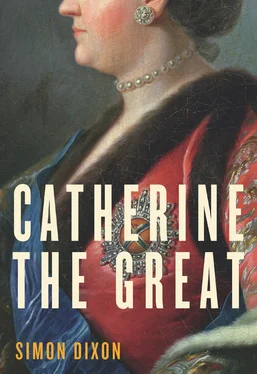Mikhail Vorontsov tried to forestall rumours in Europe by sending a circular to the Russian ambassadors on 19 December:
For several days, all Her Imperial Majesty’s faithful subjects have been in a state of general sadness and wild alarm on account of an illness deriving from a fever which at first seemed dangerous because Her Majesty, out of a natural aversion to doctors, was reluctant to see one, and her blood was so inflamed that it caused her to vomit. But as result of two bleedings administered over three days, the fever has so far dropped and the illness so far changed for the better this seventh day of the crisis, that, thank God, the misery into which we were all plunged is now transformed into ravishing transports of joy by the great hope we have that with the aid of Divine Providence, the Empress will soon entirely recover her precious health. 28
He was hoping against hope. By the time the ambassadors received his message, it was already too late. The Court journal for Elizabeth’s reign falls silent on 24 December. She died the next day.
In the event, all Catherine’s dreams of seizing the throne came to nothing. Pregnant and politically isolated, she could only stand by as the Shuvalovs and Vorontsovs ensured that all Russia proclaimed the advent of Tsar Peter III—and she became his empress.
* * *
By the time of her husband’s accession, he and Catherine had long been leading separate lives. In that sense, little now changed. The thirty-four-year-old tsar rose at seven and gave his first orders of the day while dressing. By eight, he was in his study to hear the Procurator-General, Alexander Glebov, deliver his reports. Occasionally Peter visited government offices unannounced to keep negligent officials on their toes. Regularly at eleven, he inspected the parade in the square outside the palace. Although he called on his new empress most mornings, they rarely dined together. 29While she ate with senior courtiers, he preferred to eat with Elizabeth Vorontsova and carouse in the company of Prince Georg Ludwig, the very same uncle who had courted Catherine twenty years earlier and was greeted with great pomp on his arrival at the military encampment Krasnoye Selo on 23 January and later lodged at Ivan Shuvalov’s palace. 30Even on ceremonial occasions, the imperial couple played roles that kept them apart. At the Blessing of the Waters at Epiphany—a ritual revived in all its splendour at the beginning of the new reign—Catherine followed the icon procession to the Jordan on the Moika while the tsar emulated his hero Peter the Great by riding at the head of his troops. 31Though they were unavoidably brought together for the funeral procession of Peter Shuvalov, which they watched from the balcony of the Stroganov Palace on 21 January, the tsar arrived late and there was little contact between them. 32
Though Shuvalov’s funeral was exactly the sort of elaborate ritual that Elizabeth despised, the most extravagant obsequies were reserved for the late empress herself. The day after her death, the tsar allocated 100,000 roubles to the newly appointed funeral commission which met daily at the mansion of the disgraced Chancellor Bestuzhev. The commission established after Anna’s death in 1740 offered the most recent precedent, though it was not to be emulated in every respect. Almost 45,000 roubles of its total budget of 65,000 had been spent on velvet, taffeta and other fabrics, to the neglect of the corpse itself: ‘She had lain in state for a month,’ a British visitor remarked, ‘but not having been rightly embalmed was almost fallen to pieces before her burial.’ 33Now, while work went ahead ‘day and night’ on Jacob Stählin’s designs for an allegorical chamber of mourning in the wooden Winter Palace and an elaborate catafalque in the Peter-Paul Cathedral, leading courtiers gathered on the evening of Monday 14 January to convey the corpse to the stateroom where it was first displayed to the Court. Dressed in her favourite virginal white, the late empress was laid out on a lit de parade on a dais covered in white cloth under a canopy trimmed with gold. The walls of the room were also draped in white cloth edged with gold braid. 34
On Friday 25 January, Elizabeth’s corpse was transferred to lie in state in a second chamber of sorrows, where Stählin had gone to elaborate lengths to represent the Russian realm weeping at the tomb of its beloved ruler. 35At two in the afternoon, the Captains of the Guard formed a new guard of honour in this much darker chamber, draped in black and adorned with festoons of silver brocade. Twelve Chevaliers Gardes placed the coffin, covered with a pall of gold cloth trimmed with Spanish lace, on a raised catafalque beneath a canopy emblazoned with the imperial crown. By its side stood four ladies-in-waiting, dressed in deep mourning, and entirely covered with crepe veils. Two officers, in full dress uniform, stood guard on the first step, while two archimandrites, standing at the foot of the coffin, took it in turn to read aloud from the Bible throughout the day and night. 36
Yakov Shakhovskoy—a far from sentimental bureaucrat whose memoirs mention his wedding only as a temporary interruption to his work—was overcome with emotion at the sight of his late sovereign. 37Bowing twice on approaching the corpse, which was now dressed in a silver gown, trimmed with lace sleeves, he joined the procession of Russians who prostrated themselves before it, or rather ‘threw themselves face down on the ground in front of the bed’ so violently that at least one foreign observer ‘feared that they must fracture their skulls’. 38‘There is a multiplicity of such customs,’ the supercilious French ambassador reported, ‘full of superstitions at which [Catherine] naturally laughs, but the clergy and the people have faith in her deep grieving over the deceased and rate her feelings very highly.’ 39
According to Pauzié, the Court jeweller, it was Catherine rather than the tsar who summoned him to this ‘large room, lit by six thousand candles’, where he helped her to place a gold crown on the swollen skull of the deceased. Since Pauzié had ‘taken the precaution of placing several screws in the band that gripped the forehead’, he was able to use his tweezers to make the crown big enough to fit. But it was not a pleasant operation. ‘Despite all the incense and fragrance, the smell of the corpse was so strong that I could hardly stand near it. However, the empress bore all this with amazing fortitude and in this way completely won over the hearts of her subjects.’ 40
Peter made no secret of his impatience with such rituals and visibly chafed against them. Courtiers had been shocked to discover that deep mourning was not immediately prescribed when the empress died. 41Scarcely had the corpse been transferred to its second chamber of rest than Peter ordered them to abandon mourning dress altogether on future Sundays and feast days. That night, 27 January, he and Catherine dined with Prince Trubetskoy, returning to the palace at three and two in the morning respectively. 42On Monday 4 February, the tsar was taken incognito to inspect the final preparations at the Peter-Paul Cathedral, promising further funds to ensure that the spectacle lacked nothing in magnificence. (The funeral commission’s outstanding expenses of 74,000 roubles were ultimately paid by Catherine shortly after her own accession.) While he spent the evening drinking with Prince Georg until three in the morning, his wife, now six months pregnant with Orlov’s child, remained in her apartments in order to be at her most demure for the next day’s funeral. 43
Following a pattern established after her father’s death in 1725, Elizabeth’s coffin was borne with great pomp to its burial place on the far side of the frozen Neva, where, between the cathedral’s four main pillars, Stählin had created a Temple of Sorrow and Remembrance with a life-size half-length portrait of the late empress. 44The capital’s bells began to toll at ten as troops lined the route of the procession. Three hundred guardsmen led the way, followed by an even larger number of priests, processing two by two and chanting hymns. Behind them, in single file, came the gentlemen of the Court, wearing the uniforms of the various orders of chivalry, and each attended by a chamberlain. A single cavalier, armed from head to toe, rode ahead of the coffin on a stately charger held by two equerries. Released from captivity in the fortress by the pro-Prussian Tsar Peter, Count Hård was there to observe the scene:
Читать дальше












